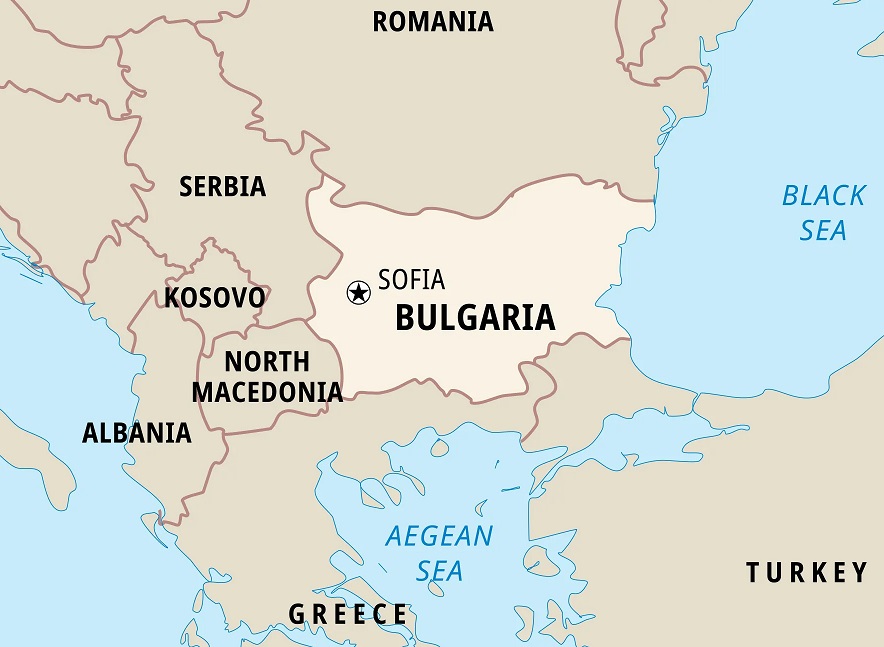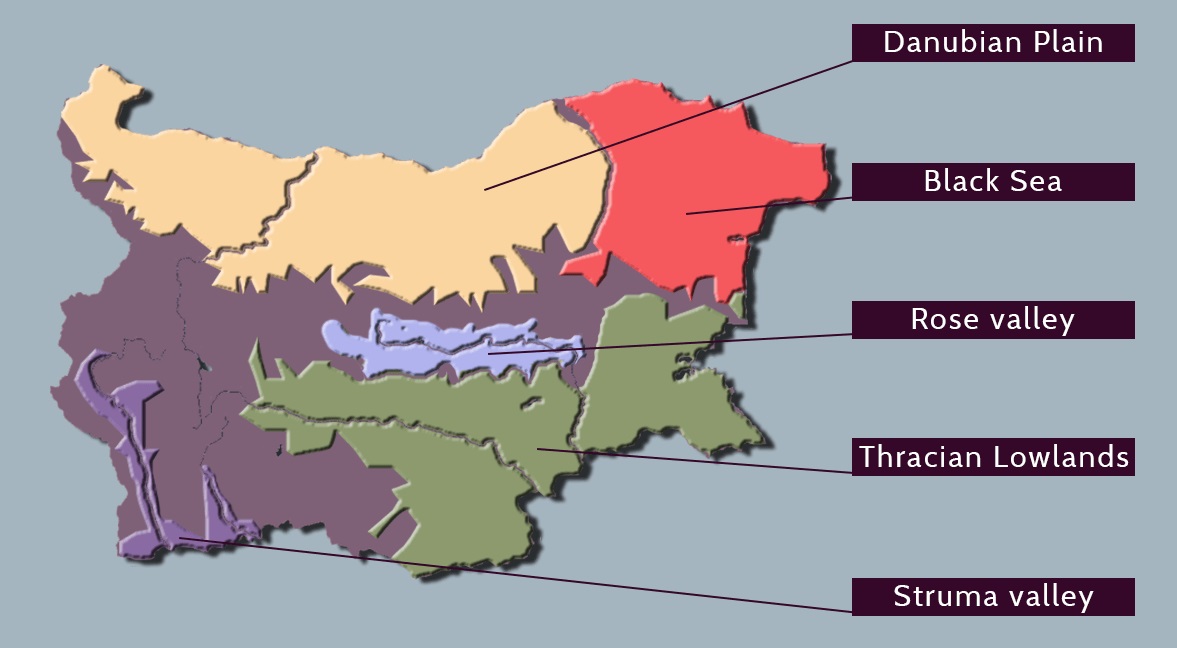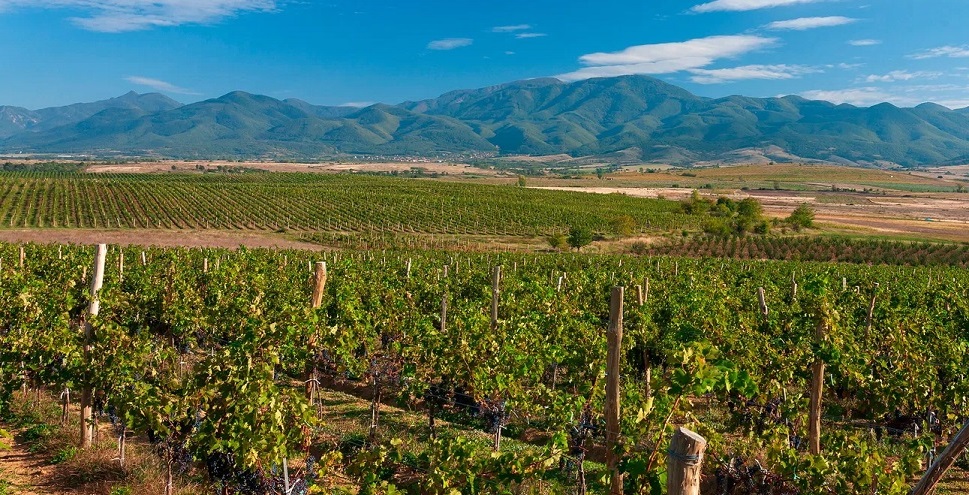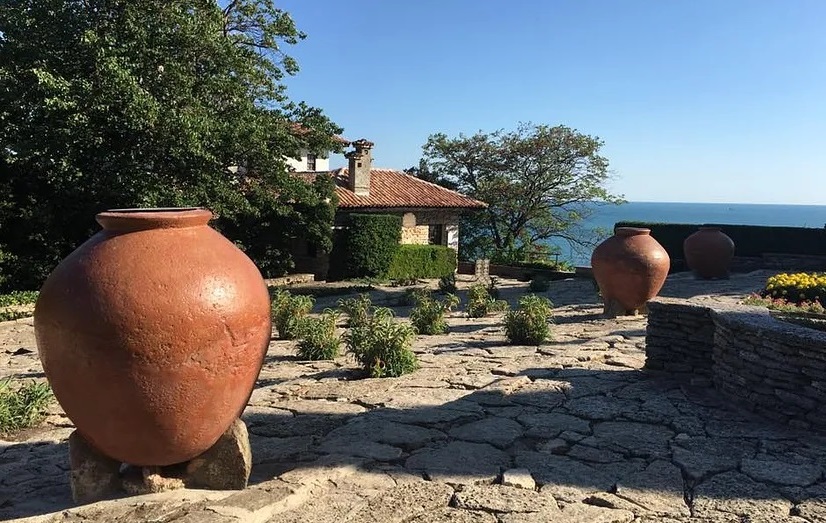Bulgarian Wine
Bulgaria is located on the eastern portion of the Balkans, south of the Danube river and west of the Black Sea.
It is bordered by Greece and Turkey to the south, Serbia and North Macedonia to the west, and Romania to the north.

History
Bulgaria has a long and rich history of winemaking, dating back thousands of years to Thracian times. Although production dipped during the post-communist transition in the 1990s, Bulgaria is once again gaining recognition for quality wines, combining tradition with modern winemaking techniques.
Bulgarian Red Grapes
Mavrud
The local red flaghip. Deep-colored, robust and spicy.
Believed to date back to ancient Thrace, Mavrud is a red grape that has been grown for centuries only in the area of ncient Philippopolis, north of the Rhodopes. The grape is usually used to make wines with a mild taste and dark, rich color. Its cultivation is difficult and requires special attention, however worth the effort.
Melnik (Shiroka Melnishka Loza)
Rustic, aromatic, ages well.
Melnik is a red wine grape found in the Struma River valley, that has a typical Mediterranean climate.
According to the legend, Melnik is among Winston Churchill's favorites.
The grape produces powerful wines with a rich texture, exotic perfume and soft tannins.
Rubin
A Bulgarian cross between Syrah and Nebbiolo.
Rubin is a grape with a typical dark purple color. It is mostly planted in the Thracian Lowlands on the border with Strandzha Mountain. Rubin wines are characterised by a rich taste and color.
Pamid
According to legend, the ancient Thracians were avid fans of Pamid wines, characterised by a pleasant freshness and fruity taste. Although widely cultivated by the Thracians for centuries, today it is grown mainly in the Thracian lowlands.
Gamza
Cultivated since ancient times, the Gamza variety, also known as "Kadarka" in many Balkan countries, is best grown in the Danube region. The wine is characterised by a bright red color, with a pleasant fruity taste and captivating freshness.
The variety requires specific climatic conditions, and is grown mainly in the Danube plain as a result.
Cabernet Sauvignon and Merlot
Widely planted, often blended with locals.
Bulgarian White Grapes
Dimyat
Indigenous, delicate and floral.
Dimyat has been one of the most popular wine grapes in the Black Sea region for centuries, where it is used to produce both still and sparkling wines.
The wines have a sweet taste, strong aroma and a light amber color.
Red Misket
Light, crisp, slightly floral.
Muscat Ottonel
Aromatic, used for dry and dessert wines.
International Grapes
Chardonnay, Sauvignon Blanc, Riesling.
Bulgarian Wine Regions

Bulgaria is divided into 5 wine-growing regions, each with its own climate, soil, and grape varieties.
- Thracian Lowlands (Southern Region)
- Danubian Plain (Northern Region)
- Black Sea Coast (Eastern Region)
- Rose Valley (Sub-Balkan Region)
- Struma Valley (Southwestern Region)
Thracian Lowlands

Thracian Lowlands is one of the most prestigious wine regions, especially for full-bodied reds. It is representing 35% av the Bulgarian vinyards, and is home to many top estates.
This Southern Region is bordered by the Balkan Mountains to the north, the Rhodope Mountains to the west and southwest, and the Strandzha Mountains to the east.
- Climate
Mild with Mediterranean influence. - Soil
Sandy and loamy. - Red Grapes (dominant)
Mavrud (indigenous), Merlot, Cabernet Sauvignon, Rubin. - White Grapes
Chardonnay, Viognier.
Danubian Plain
The Northern Region is bordered by the Danube to the north and the Balkan Mountains to the south and west.
The Danubian Plain accounts for 30% of the vineyards in Bulgaria and is home to numerous wineries, from small family-owned estates to larger commercial vineries.
The region produces both still and sparkling wines. Gamza is a local specialty here.
- Climate
Continental – hot summers, cold winters. - Soil
Chalky/limestone to fertile black, humus-rich with loess along the river. - Red Grapes
Cabernet Sauvignon, Merlot, Pamid, Gamza (Kadarka). - White Grapes
Chardonnay, Sauvignon Blanc, Muscat Ottonel, Aligoté.
Black Sea Coast

Photo: Queen’S Winery House
The Eastern Region is bordered by Romania to the north, the Black Sea to the East, and Turkey to the south.
The Black sea region is characterized by mild autumn which allows growing white varieties with a high sugar concentration.
The region is ideal for early ripening varieties, and is best known for fresh, aromatic white wines. Of the reds, Pinot Noir is definitely the star of the region.
- Climate
Moderate continental with maritime influence from the Black Sea, creating lower summer temperatures. - Soil
Sandy and clay-limestone. - White Grapes (dominant)
Dimyat, Muscat Ottonel, Riesling, Sauvignon Blanc, Traminer. - Red Grapes
Pinot Noir, Cabernet Sauvignon.
Rose Valley (Sub-Balkan Region)
Rose Valley, is located between the Balkan mountain and Sredna Gora. The region is famous for producing elegant, aromatic wines. Also known for rose production. (Bulgaria grows 85% of the world’s roses!!)
The Valley is the birthplace of the Red Misket – a white grape with pink skin which produces white aromatic wines similar to those of the Muskat family.
- Climate
Temperate with mountain influence from the Balkan range. - Soil
Sandy-loam and clay. - White Grapes
Muscat, Riesling. - Red Grapes
Cabernet Sauvignon. Merlot. - Red Misket
A local white grape with pink skin.
Struma Valley (Southwestern Region)
The Struma Valley includes the valley of the Struma River and is part of the historical region of Macedonia. It is a very small but unique region. The native Melnik grape creates spicy, earthy reds with aging potential.
- Climate
The warmest region in Bulgaria. Mediterranean climate, with mild, rainy winters and hot summers. - Soil
Sandy and alluvial. - Red Grapes (dominant)
Shiroka Melnishka Loza (Broad-leaved Melnik Vine), Melnik 55 (a hybrid),
Cabernet Sauvignon, Merlot.
The Modern Wine Scene
In recent decades, Bulgaria has seen a boom in boutique wineries, many focusing on quality over quantity. There is a renewed emphasis on native varieties, terroir expression, and sustainable practices.
Wine tourism is also growing, especially in the Thracian Lowlands and Struma Valley.